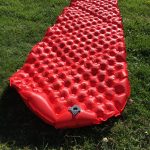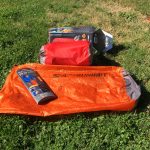This is your body under pressure.
Hormones rocket like flaming ping pong balls all around your brain. Your breathing turns fast and erratic. Your heart pounds mercilessly but your blood vessels have constricted, choking off the flow of vital oxygen. Your muscles are at DEFCON 1. Maximum readiness.
There are two results that can come from pressure. It can be what inspires us to complete fantastic feats or it can make us falter under our own weight, dropping the ball when our performance means everything.
It can set in over a period of a few days or hours. Work slowly piles up. Orders build up in the kitchen of our minds, the dinner rush soon growing unstable and furious. Confusion leads to stress. Stress leads to panic. At the office, on a family camping trip, or in a small beach down with a tsunami bearing down on you, you must manage your stress levels or face the consequences.
Fearless first responders, flame singed chefs, and world famous elite athletes each have something to teach us all about how to stay calm when life cranks up the pressure.
1:Prioritize problems by working triage.
The train smashed into a semi struck loaded with steel at 9:47pm. On that night in March of 1999, the citizens of Bourbonnais, Illinois experienced one of the biggest accidents in US history. An Amtrak train collided with the truck that was blocking the crossing, resulting in 11 deaths and over 122 injuries.
When first responders arrive on the scene like this one, they’re overwhelmed with tasks almost instantaneously. All of a sudden, every move they make and every second they spend pondering a choice could mean the difference between the life or death of a total stranger. The situation is chaotic, filled with noise and disturbing scenes. From the very first moments, they use a system called START, or “simple triage and rapid treatment”.
They immediately begin organizing and evaluating victims based on their condition. They quickly and confidently place the injured into one of four categories: Immediate (red), Delayed (yellow), Walking Wounded/Minor (green), and Deceased/Expectant (black). Responders are instructed to follow practiced protocols and evaluate each victim in only a minute or two. They instruct anyone who can wait for delayed treatment to move away to a specific area, leaving those who need more urgent care identified and accessible.
First responders are well-trained and practice frequently for situations just like this. The START triage process requires confidence and education. But that doesn’t mean you can’t use something like it to manage yourself in your own stressful situations.
When you have a 10 car pileup of important tasks crashing in your brain, stop and work triage on the list. Move the tasks that can be delayed away from the tasks that need urgent attention. If the situation is confusing and uncomfortable, get a bead on what you do know and focus on that. Being able to discern the differences between what’s essential and what can wait can earn you precocious seconds when time is short.
2:Stay organized to avoid confusion.
Keeping your various projects organized can help you stay calm while others are in the weeds. Unpredictability ramps up stress and pressure to unmanageable levels. Staying organized keeps life predictable, and that can do wonders for scaling down the stress.
Popular restaurants are able to keep large rushes of customers happy and full with a kitchen crew that is fast and, above all, meticulously organized. By staying organized, chefs and cooks handle the stress and chaos of flying orders while wielding razor sharp knives and flaming hot pans.
By dividing up the work into organized stations, successful kitchens manage to handle thousands of meals every week. A trained cook at the saute, grill, fry, and salad stations can field hundreds of orders each night with the confidence that the others are also doing their part. The stations are organized to work together and create a finalized order that would be impossible for only one cook to prepare.
How does a restaurant kitchen relate to your survival? In more ways than you think, it turns out.
Clutter and chaos is hazardous to your health. Research shows that people who are surrounded by clutter and unfinished projects have increased depression and stress levels. These affect your sleep, your eating habits, and ultimately your ability to handle tasks effectively. Unorganized people often feel ashamed of the appearance their office or home, and in turn may avoid more investing in deeper relationships.
Keep your supplies and gear in the same easily accessible location for quick access. Divide complex projects up into more manageable sections and assign tasks to others based on their skills. Fight against the negative effects of unpredictable situations by planning well. Look ahead and learn about what supplies or skills you may need well in advance.
3:Make pressure work for you.
Pressure has a negative effect on just about every part of our movement and our ability to plan and solve problems. Stress hurts our bodies and inhibits our success. It would all seem to result in pressure causing worse performance, not better. But you can take the pressure and turn it around. You can actually make high stakes moments work for you, not against you.
How? Looking at athletes who consistently perform at high levels can illustrate just how it can work.
For elite athletes, exceedingly high expectations and a fear of failure can pile up and drastically inhibit performance. It’s vital that they learn to block out the millions of eyes that they know are watching their every move and act on instinct and training. How do they move past fans’ expectations of near flawless play night after night, often under punishing physical circumstances? They fail. And they do it frequently.
They’ve learned to make pressure work for them by understanding the inevitability of mistakes. They, very unlike their fans, understand their limits and accept imperfections. They expect success and work insanely hard to achieve it, but they know that on any night they may win or they may lose. The outcome of the contest may even rest upon their shoulders and they could very well fumble the opportunity. All they can do is put in every single ounce of effort they can muster and hope that they are in a place that makes success inevitable.
Don’t let a fear of mistakes and missteps stop you from doing your absolute best to handle a high pressure situation. Every hand is needed in a crisis. Emergencies don’t wait to happen to people who are prepared, they happen to anyone and everyone regardless of ability and preparation. No, you may not execute every task with perfect skill, but you fearlessly did your best to make the situation better. An that’s what counts in the end.
You can’t avoid pressure. You can’t live a life with no stress. The best you can do is prepare. Learning what it takes to lead, study what it takes to handle yourself in the face of chaos, and practice what it takes to survive.









